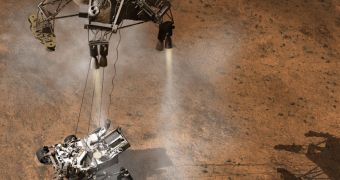Mission controllers at the NASA Jet Propulsion Laboratory (JPL), in Pasadena, California, announced yesterday, July 6, that the Mars Science Laboratory (MSL) rover Curiosity is now less than a month away from the Red Planet.
It is scheduled to touch down on the slope of Mount Sharp, inside Gale Crater, on August 6 GMT (August 5 PDT). Recently, scientists narrowed down the landing ellipse for the mission, with the purpose of landing Curiosity closer to Mount Sharp.
Several course corrections have already been conducted mid-flight, all of which succeeded well within established parameters. Still, JPL technicians are preparing themselves mentally for the 7 minutes of terror, which will occur as the MSL starts entering the Martian atmosphere.
This mission will have the steepest angle of approach ever attempted, with regards to our neighboring world's surface, and will be the first to use the innovative Sky Crane landing system. In addition, a sequence of 76 pyrotechnic blasts needs to occur in a precise order, so that the landing can succeed.
Engineers selected Sky Crane for use on the MSL because Curiosity is the largest rover ever sent to another planet. Weighing nearly a ton and about the size of a Mini Cooper, the massive robot could not be landed using the standard airbag system that NASA used for Spirit and Opportunity.
Now that all necessary mid-flight maneuvers are completed, the team is not left with much to do. Experts at JPL simply sit around and wait for the mission to reach its destination, all while anticipation (and a certain amount of stress and dread) builds up.
“I think people are kind of waiting. It's a little bit like waiting for a final. You're patiently counting down the days,” MSL deputy project manager Richard Cook told Space in an interview.
He went on to add that Curiosity is more complicated than other Martian rovers in nearly all ways possible. It is the first explorations robot that features a Radioisotope Thermoelectric Generator (RTG) as a power source, as opposed to standard, foldable solar panels.
After it lands, the rover will focus its efforts on analyzing the exposed geological strata inside Gale Crater in general, and the slopes of Mount Sharp, in particular. The latter is in fact a cone of material that was ejected from the planet's surface following the asteroid impact that created the crater.
Still, Mount Sharp is about 3 miles (5 kilometers) high, and has some gentle slopes. JPL experts hope they will be able to drive Curiosity uphill for a while, sampling a multitude of rocks as it goes.

 14 DAY TRIAL //
14 DAY TRIAL //